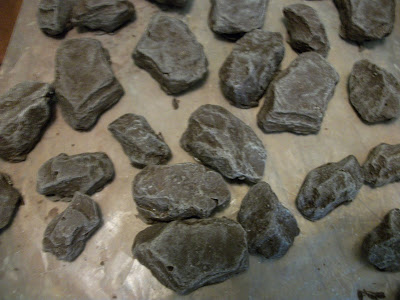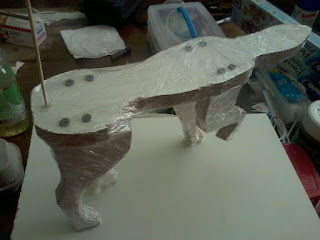Hello!
On Thursday, I made a wolf cake for my cousin's Birthday to try out some new techniques. It was my first time making a "gravity defying" cake with an armature, so I thought documenting the process might help others interested in making this kind of cake. !)
I am also a 3D graphic artist, so the way I drafted the plans for my armature were, perhaps unorthodox.
I sculpted a rough wolf model in ZBrush.
Added some boxes where the support boards would be (body and legs).
Then performed an intersection boolean operation on them.
After that, I just arranged the pieces so that they were all on the floor and took a screenshot from above.
If all those steps sound like gobbledegook, just sketch out your plan with a good ol' pencil on paper. Just make sure that all the legs that touch the ground are the same length, so that the cake board will be level.
I also used an image of the profile of the wolf as a reference for carving.
Here are the final images for the plans:
I printed them at 72 dpi for a cake about 16 inches long from nose to bum. You can print them at any size depending on your cake size needs. :)
Cut out the shapes and tape them together wherever necessary.
I was so focused on building the armature, that I forgot to take pictures. You'll need basic woodworking skills for this part of the project. You'll also need a jigsaw and a drill with an apropriate drill bit for drilling pilot holes, as well as a 1/2" board large enough to cut your pieces and display board out of, screws and a screwdriver. I used 1 1/4" wood screws.
I traced the shapes onto 1/2" melamine shelving board. The kind I used was about 15" wide and 30" long, it was $13 from Lowes, and I used about half of it.
Cut out the shapes with a jigsaw.
Position the legs where they should be on the bottom of the body support board. Trace the top of the leg with a pencil onto the bottom of the body support board. Mark where the screws should go. I put two in each leg. Use a ruler to mark corresponding drill marks on each of the legs. If you don't want to use screws, it may be possible to use hot glue instead, but it will not be quite as sturdy. If you are making a larger cake than the one shown here, I would not reccomend it. A smaller one would be fine.
Drill your pilot holes where you have marked them. Drill all the way through the body support board and about 1/2" into the legs.
Put your screws into the holes from the top of the body support board. I prefer to drive them with a regular screwdriver to avoid splitting the board, however, you can use a driver bit in your drill if you prefer. Once the screws are poking through to the bottom of the body support board, add the legs, one at a time making sure that the pilot holes in the legs are aligned with the screws. Hold the leg firmly while you drive the screws into it.
Once all your legs are attached, position your wolf on the display board and trace all three feet onto the board. Position pilot holes carefully so that the screws will go into the verticle part of the leg rather than right through the foot. I put screws only into the back two feet, and reinforced with hot glue. I also glued down the front foot with hot glue.
Cut four small blocks out of the scrap shelving board. Use hot glue to affix them on the bottom of the display board to create "feet." If you plan to use a turn table for decorating, make sure the feet are positioned so that they fit around the outside edge of the turntable plate.
Your armature is now complete!
Because plywood, particle board, and press board can contain harmful substances, make sure you cover the entire armature with a double or triple thickness of plastic wrap. Wrap it TIGHT! If the plastic wrap sags, it can cause problems when you start sculpting your cake. If you want to be super sure it won't sag, you can use double-sided tape, or brush some glue, melted marshmallow, or corn syrup over the surface before applying the plastic wrap.
Now that your armature is securely wrapped in plastic, make a nice fresh batch of rice crispy treats. Since my whole cake was chocolate/peanutbutter flavour, I made mine with cocoa krispies and peanutbutter in place of butter.
Melt some extra marshmallows with a little bit of water. I used four regular-sized marshmallows and about 1/2 teaspoon of water. Use a spatula to spread the marshmallow goo over the plastic wrap on all the surfaces of the armature except the top of the body support board. I had to use my small offset spatula to get into the narrow places between the leg boards.
Use the rice krispy treats to fill in the chest, neck, thigh, and shoulder areas.
Torte one 9"×13" cake. Leave the two layers stacked. Mark out intervals of about 3 1/2" along the short sides of the cake cut the cake along the marks so that you wind up with three long strips of cake, two 3 1/2" wide and one 2" wide.
Spread a thin layer of ganache over the top of the support board.
The board is longer than 13" so you will need to stack and fill the 3 1/2" wide cake layers toward the back end of the support board. Cut the extra 2" strip of cake into wedge shapes for the head. Stack and fill the head and glue it to the body with more ganache.
Refrigerate until the ganache is firm.
Now it's the fun part! It's time to carve the cake. Use your reference image to carve by and have fun. Make sure you don't stress over it too much. If you over-carve, you can always fill it back in. To fill in an anemic part of the cake, just take some of your cake carving scraps, preferably the scraps that have a bit of ganache in them, and squish it between your fingers until it turns into a cake pop like consistency. Press it into the area to bulk it up. I used this technique to round out the haunches and shoulders.
Crumb coat the cake. I like to get a nice even layer of ganache on the cake (and over the rice krispy treats), then, I just cover the whole thing with plastic wrap and use the plastic wrap to smooth and shape the ganache. Much easier than trying to smooth it with a spatula. Refrigerate until the ganache is really firm. If the ganache is too soft, it will pull off with the plastic wrap and make a big mess.
I spaced a little on this next step as well... Covering the cake.
I used a 2:1 MMF/modelling chocolate mix to cover the cake. The mix dries out much more slowly than straight up fondant, and tastes better, too. :)
Instead of covering the whole cake with one big sheet of fondant, I covered it in stages, to create a more layered, furry look. I started with the back legs, then the haunches with the tail attached, then the torso, the front legs, the shoulders, the neck, and finally, the head. The next time I make a cake like this, I'll remember to document the process of covering the cake. O:)
I used
Elisa Strauss' fur impression mats to do the texture on the fondant, and I did the finer sculpting details using "Color Shapers." Color shapers are my new favourite sculpting tools. I've seen them reccomended on various blogs and in several tutorials and classes lately. I was a little skeptical as to how much more useful they would be than the usual sculpting tools I had, so I wasn't prepared to spend a lot on them. I bought
this set from Amazon.com. They really are the shiz. I love them! They saved time, they blended seams easily, and they were awesome for sculpting details. I love the range of sizes that came in the set I got.
Then, came my first airbrushing experience. I got an
inexpensive airbrush from harbor freight, along with some couplers to allow me to attach it to my regular 6 gallon air compressor, and a set of Americolor airbrush colors. I only used two colors, black and chocolate brown, thinned with vodka. I didn't have time to clean the airbrush between colors. I sprayed black, then brown, didn't have any trouble.
After airbrushing, I painted some additional detail on the face using my gel colors and paint brushes. The cake was done! I was quite pleased with it.
All that's left is the cake board. I've got some 1" wide ribbon that I glued around the edge of the board to create a bit of a lip. I crumbled up what was left of the scrap from carving the cake and pressed it lightly onto the board. It makes pretty convincing "dirt." To add a little more realism, I sprinkled some graham cracker crumbs that I'd dyed green around the board for moss, and
chocolate rocks.













































